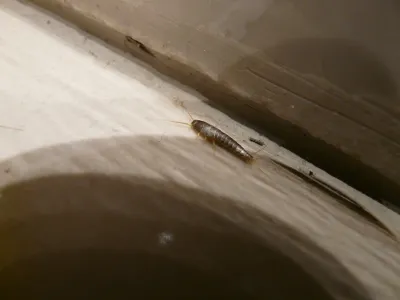About Silverfish
Silverfish are small, wingless insects recognized by their silvery-gray color, teardrop shape, and quick, wriggling movements. Although they do not bite or transmit disease, they are considered nuisance pests due to their ability to survive in a wide range of indoor environments. Silverfish are highly adaptable and often go unnoticed as they hide in dark, humid areas like basements, bathrooms, and kitchens. Their presence can indicate moisture problems and may lead to gradual damage if left untreated.
What Do Silverfish Look Like?
Silverfish are small, wingless insects with a silvery-gray, teardrop-shaped body and quick, fish-like movements. They typically measure about ½ to ¾ inch long and are easily recognized by their metallic scales and three long, bristle-like appendages at the rear. Key features of silverfish:

- Silvery-gray color with a metallic sheen.
- Teardrop-shaped, flattened body.
- About ½ to ¾ inch (12–19 mm) in length.
- Long antennae on the head.
- Three tail-like bristles at the end of the body.
- Wingless and fast-moving, with a wriggling motion.
What Do Silverfish Eat?
Silverfish primarily feed on starchy materials and organic substances found around the home. They are scavengers and will consume a wide variety of items, especially those containing carbohydrates and polysaccharides. Common food sources for silverfish include:
- Paper products (books, wallpaper, glue in bindings).
- Fabrics made from natural fibers like cotton, linen, and silk.
- Stored pantry items like flour, cereal, pasta, sugar, and pet food.
- Dead insects, hair, dandruff, and other organic debris.
- Household items containing starch or glue, such as carpets and shampoos.
Their diet is one of the reasons silverfish are commonly found in kitchens, bathrooms, and areas with high humidity, where these materials are often present.
Are Silverfish Harmful?
Silverfish are not harmful to humans or pets in a direct way, they do not bite, sting, or spread disease. However, they are considered nuisance pests because of the damage they can cause to personal belongings and household items. Reasons silverfish are considered harmful include:
- Damage to books, wallpaper, and important documents.
- Holes or yellow stains on clothing and fabrics.
- Contamination of stored food products.
- Signs of moisture issues in the home, as they thrive in humid environments.
While not dangerous, their presence can lead to costly damage over time, especially if left untreated.
How To Get Rid of Silverfish
Getting rid of silverfish requires a combination of moisture control, sanitation, exclusion, and targeted treatments. Because they hide well and reproduce quickly, a thorough approach is key to eliminating them and preventing future infestations. Steps to get rid of silverfish:
- Reduce humidity: Use dehumidifiers and improve ventilation in basements, bathrooms, and attics. Silverfish prefer humidity levels above 75%.
- Eliminate food sources: Store pantry items in airtight containers and regularly clean up dust, crumbs, and organic debris.
- Seal entry points: Caulk cracks and gaps around doors, windows, baseboards, and pipes to block access.
- Use traps and natural repellents: Sticky traps can help catch silverfish; natural deterrents like cedar oil or bay leaves may discourage activity.
- Remove clutter: Minimize piles of paper, cardboard, and fabric where silverfish can hide and feed.
- Apply insecticides if needed: Insecticidal dusts, sprays, or foggers can be used for severe infestations, but should be applied carefully, especially in homes with children or pets.
For persistent or widespread problems, professional pest control services are often the most effective solution. Contact Affinity Pest Control for expert treatment and long-term protection.